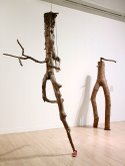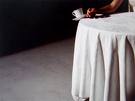We’re experiencing a crisis of engagement with the Turner Prize. In many ways, maybe it’s not surprising. Since it started in 1984, it has borne the brunt of countless critiques and attacks from all sides for its undemocratic approach and often-controversial shortlists. How can the average visitor be expected to view the show without prejudice, when the media has set it up as the emblem of everything that is supposedly wrong with British art today?
Many viewers approach the show with pre-meditated contempt, unwilling to take their experience of the exhibition at face value. This metaphorical barrier might be down to a lack of confidence in our own convictions. Countless visitors to the exhibition, if not unwilling, feel inadequately prepared to initiate a personal response to the works. It is widely assumed that the Turner Prize shortlists a particular type of art, a type that uses unusual media and presents a complex conceptual message: work that is believed to
be ‘difficult’.
Many people feel that an advanced knowledge of contemporary art is required to extract meaning from the work. They are further alienated when they consult the captions on the wall, and their thoughts do not accord with the supplied interpretation. Curators can say all they want about dichotomies or questioning of the self, but by placing these assertions on the gallery walls, I think they’re contributing to the widespread disillusionment with the Prize that was only too evident at this year’s exhibition.
Goshka Macuga’s installation is an assemblage of several seemingly divergent works. A rainstorm, drawn simply in pencil, covers each wall. On top of this hangs a series of surreal scale-bending photo-collages depicting such things as an anatomically drawn hand touching the tip of a rocky cliff. Dominating the room are three large glass and metal geometric constructions with names like Deutsches Volk-Deutsches Arbeit. It’s all pretty subtle: concerted looking is rewarded with some interesting visual material, but it isn’t easy to see any connection between the works. Consult the caption, and you’re informed that it is, in fact, all about the relationships between Paul Nash and Eileen Agar and Mies van der Rohe and Lilly Reich. Apparently, we’re welcome to consider a political reading related to the promotion of German industry too. Well that was obvious, wasn’t it?
Glasgow-based artist Cathy Wilkes has installed two supermarket checkouts, female mannequins, dirty dishes and various other paraphernalia of modern life in the next room of the exhibition space. One near-naked mannequin wears a hamster cage on her head as she leans back onto the checkout, pushchair alongside. On the conveyor belt are rows of dirty bowls, some of them containing a single upright battery. What does it all mean? A depiction of a post-credit crunch Tesco? A feminist critique of women’s place in society? A celebration of the energy-giving powers of a bowl of porridge in the morning? The most interesting thing about this surreal installation is the variety of interpretations that could be drawn from its many layers. It seems pretty brutal to terminate all that before it has begun by proclaiming that it shows, as the exhibition text baldly declares, an ‘uncompromising questioning of the self’.
Runa Islam’s films are perhaps the most visually pleasing works in the show. One depicts a woman slowly and gracefully smashing chintz crockery, the cups and saucers viewed in detail to accentuate their delicate physical qualities. However, the repetition, stillness and silence of the films, as with a lot of video art, seemed to put off many audience members, who hurried through these works after only watching for a few seconds. Perhaps this time I can’t lay all the blame on the captions or the Prize itself, but it’s certainly true that since its inception, video art has not been the easiest of media for art novices, or even art nerds, to engage with.
Maybe this is why Mark Leckey was so popular with the massive number of visitors, who, on the comments board in the final room, made comments like, ‘Leckey speaks to the people’. The artist-narrated video that forms the centre piece of his submission features mass culture references to The Simpsons, Garfield and the Titanic, as Leckey muses on varying subjects such as cinema and cats. I’m not trying to make out that the Turner Prize audience only ‘got’ it when they had something easily recognisable explained to them, or indeed that people liked it simply because it was the end, and they were finally offered the chance to sit in a comfortable chair. But after the ridiculously complex jargon of the exhibition’s captions, it was certainly a relief to hear some down-to-earth conversation.
It is an interesting, but not ground breaking shortlist, an exhibition in which there is plenty to move, amuse and engage the audience. Given the problematic framework in which the work is now presented, the question of whether or not the artists will get the reception they deserve is another matter entirely.
The Turner Prize 2008 exhibition is showing at the Tate Britain until the 18th January 2009. You can learn more about it at www.tate.org.uk/britain/turnerprize
Lady Muck
XEROX Issue 3



